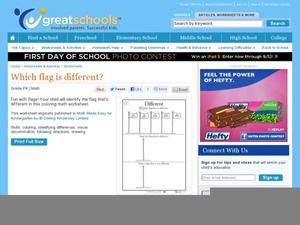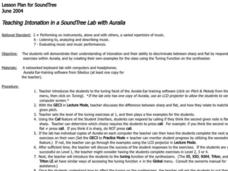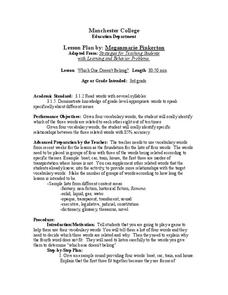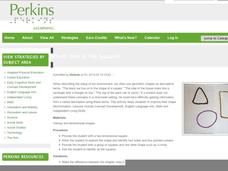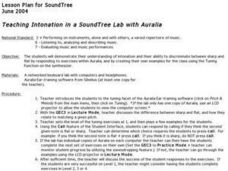Curated OER
Portraits, Pears, And Perfect Landscapes: Investigating Genre in the Visual Arts
Differentiate between the various genres in the visual arts world, particularly in Western painting. Your class can view and discuss, in small groups, paintings published on the National Galleries website. Then each student individually...
Tapps Tecnologia da Informação
Left or Right?
Help your young learners learn their left from their right and develop visual discrimination and fine motor skills with this fun, interactive, educational game.
Perkins School for the Blind
Familiar Sounds
To foster concept development and auditory discrimination skills, learners with visual impairments listen to identify a variety of common sounds. The teacher makes recordings of various sounds, including those found in the home, at the...
Perkins School for the Blind
I See Something Red
For learners with low vision, the ability to identify colors is an important skill that will help them identify people and places. Groups of brightly colored objects are placed around the room. The child is then given a colored paper and...
John Talavera
Autism iHelp – Language Concepts
A parent of a child with autism, and a speech-language pathologist together developed this language-intervention app to be used with students with severe to moderate autism.
Curated OER
Vocabulary
Fourth graders classify vocabulary words by category. Through matching and classification activities, 4th graders sort words pertaining to trees and forest habitats into appropriate categories. They discuss how vocabulary practice can...
Perkins School for the Blind
Memory
When you are blind, your hands become your eyes, so learning how to discriminate between various objects through touch is a very important skill. Make a memory game by gluing common items onto cardstock. The kids feel, identify, and...
Perkins School for the Blind
Bagging Groceries
Bagging groceries is a skill that can help learners with visual impairments understand organizing, problem solving, and weight discrimination. In addition, it is also a wonderful job skill. Help learners as they determine how to bag...
Perkins School for the Blind
Coin Identification
You got some money, and you're not afraid to use it. Before you can use that money, you need to know what it's worth. Included is a set of activity instructions that will help your visually impaired learners indentify coins. Pupils...
Perkins School for the Blind
Matching Like Objects
Same and different, sorting, and tactile discrimination are what's on the agenda for today. The class practices sorting objects and attempts to determine which objects are the same and different and why. The purpose is to increase...
Center for History Education
Continuity or Change? African Americans in World War II
While World War II was a pivotal moment in history, historians debate its importance to the civil rights movement. Class members consider the implications of segregation and the war using a series of documents and a jigsaw activity....
Achieve3000
Discriminating Phonemes
Develop the fluency of beginning readers one sound at a time with this phonemic awareness lesson. Through a series of whole-class instruction, independent practice, and collaborative learning activities, children practice...
Dorling Kindersley
Which flag is different?
Little ones build visual discrimination skills and fine motor control, while identifying differences. They circle the flag that is different, then they draw a flag that looks different than the others and the same as the others...
Curated OER
Teaching Intonation in a SoundTree Lab with Auralia
Young scholars demonstrate intonation and their ability to discriminate between sharp and flat by responding to exercises within Auralia, and by creating their own examples for the class using the Tuning Function on the synthesizer....
Curated OER
Which One Doesn't Belong?
Third graders identify words that are related with 80% accuracy. Given a list of four vocabulary words, 3rd graders identify specific relationships between three of the four words. They also identify which of the four words are not...
Perkins School for the Blind
Which One is the Square?
Children who are blind need to constantly be engaged in building conceptual understandings of the world around them. This activity will help them grasp the concept of shape, identify shapes, and consider shapes as they are used to...
Curated OER
Rain Rain Go Away!
First graders are introduced to and practice the concept of melody when connected to music. They distinguish and demonstrate melodic contour as well as sing a song with accurate melody. Each student discriminates between the pitches and...
Curated OER
Teaching Intonation in a SoundTree Lab with Auralia
Students respond to exercises using ear-training software as they decide whether notes are sharp or flat. They create their own examples using the tuning function on a synthesizer.
Curated OER
Hop Oh Bunny
Students imitate, sing, move, and discuss musical techniques in this exciting kindergarten music lesson. Emphasis is placed on the song "Hop Oh Bunny", call and response, rhythms, tempos, and the direction of pitch movement.
Curated OER
The Cat Ate My Apple
Young scholars recognize the phoneme for the short vowel a in written and spoken language. Through a variety of activities, they discriminate the short vowel /a/ from other phonemes. Students associate the phoneme with its letter...
Curated OER
A Model Lesson Plan for Teaching Phonics
First graders decode words containing the letter o when it is followed by a consonant and silent e.
Facing History and Ourselves
Identity and Place
Build scholars' ability to understand their own values and learn about World War II at the same time. Scholars write poetry and discuss identity and place in depth with an in-depth social studies resource.
Curated OER
Come Fly with Me
Students identify rhyming words from the book A Fly Went By by matching words written on index card with same endings, eliciting word when prompted by teacher, and by identifying rhyming words in the text.
Hump Software
The Writing Machine
Introduce your learners to the letters of the alphabet. They will tap to hear the name of each letter and see a word beginning with that letter appear on the screen. The highly repetitive nature of this app could be a good way to...
Other popular searches
- B D Visual Discrimination
- Visual Discrimination Math
- Letter Visual Discrimination
- Visual Discrimination Dfnatm
- Visual Discrimination Witch
- Visual Discrimination Defiant












